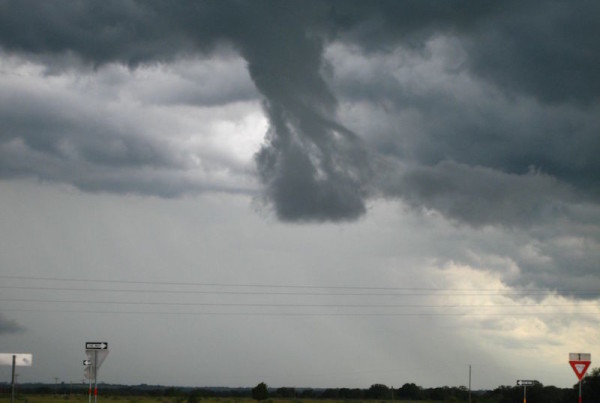This story originally appeared on KERA News.
Folks right in the path of the Christmas weekend tornadoes couldn’t do much to save their houses. For those who avoid a direct hit, building codes are supposed to protect homes from serious damage. But on a tour of one hard-hit street, an engineer who specializes in how construction holds up during a storm says that doesn’t always happen.
The wreckage is still strewn along Tricia Lane in Glenn Heights, just south of Dallas. Generator-powered floodlights hum as the sun burns off the early morning fog. Piles of rubble line the streets – in front of one house, an artificial Christmas tree is piled with furniture, clothes and broken bricks and lumber.
Tim Marshall, an Irving-based engineer and meteorologist, points to the edge of a concrete foundation, all that’s left of a home that’s been bulldozed.
“This is what your house is anchored to,” he says. And how that house is anchored to its foundation matters. In this case, all that held the house down were basic nails.
“One of two things happens: Either the wall pulls through the nail and leaves the nail as we have here. Or, it goes ahead and pulls the nail out of the concrete, which leaves little divots like we have next door,” he says.
The National Weather Service brings in Marshall after tornadoes to help figure out how buildings were ripped apart. This time, he saw a lot of inadequate construction. That’s not unusual. Some of it violates building code requirements, but a lot of the time it doesn’t – it’ll meet code. Marshall says it’s important to understand the code is only a minimum standard.
“Do you study the night before to get the minimum to pass? No, hopefully not,” he says. “Hopefully you study so you get above the minimum to pass. Well, unfortunately in this building industry you see a lot of times where the goal is the minimum.”
Not every place in Texas even has a minimum building standard because counties in Texas have limited ability to enforce building codes. Leslie Chapman-Henderson, the president of the Federal Alliance for Safe Homes, says that means there’s practically no building code in a lot of unincorporated areas.
“Most homeowners aren’t there when the house is constructed, so if there’s not a building code or there is a building code and it’s voluntary, how can you be assured that appropriate consume protections are there to make that home strong and safe?” asks Chapman-Henderson, whose group looks at standards to keep houses standing in storms.
In municipalities where there are building codes, Chapman-Henderson says small changes can save homes and lives. Fort Worth, Dallas, Arlington and many Texas cities mandate that houses be able to withstand a three-second gust of 90-mile-an-hour winds. Her group says that benchmark should be raised to 120 miles an hour.
“In the majority of tornadoes, and the majority of times, we can save those homes. And it’s not an expensive proposition to reinforce them,” says Chapman-Henderson. “But the only way that we can weave that into the way we build is by putting it into the building code.”
But changing building codes has a price, says Texas A&M Construction Sciences professor Ben Bigelow, one the construction industry is likely to resist.
“The unintended consequence of that is if the cost of housing goes up or is increased, then how many people do we alienate from the American dream of owning a home,” Bigelow says.
Back in Glenn Heights, engineer Tim Marshall also expects resistance to tougher codes. He says consumers should push builders to do it right.
“It’s up to the individual; you are responsible, yourself for taking matters into your own hands, for your own safety,” he says.
Another option, Marshall says, is to build a tornado safe room into a new home. Those reinforced concrete and steel boxes will cost upwards of a few thousand dollars but they’re meant to keep you safe if your house takes a direct hit. He says those looking to make that investment should make sure that they’re certified by the National Storm Shelter Association.















